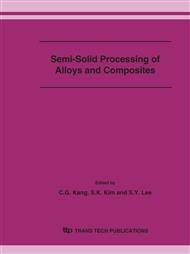p.565
p.569
p.573
p.578
p.583
p.587
p.591
p.596
p.601
Numerical Simulation of Semi-Solid Magnesium Alloy in Continuous Roll-Casting Process
Abstract:
It is significative to link the semi-solid process and continuous roll-casting process (CRP), through which we can get high quality magnesium alloy strips with non-dendritic structure and improve the overall properties of the products. Furthermore, because CRP of semi-solid metal combines casting and forming, it shortens the period of technological process. In general, several technical parameters such as the inlet temperature of semi-solid slurry, the heat transfer between roll and molten alloy, the roll-casting speed, the position of solidification final point influence on the strip quality in continuous roll-casting process. Therefore, the effects of the parameter to continuous roll-casting process should be investigated. In this paper, the finite volume method is used in the analysis of the CRP, a two-dimensional incompressible non-Newtonian flow with heat transfer is considered. Based on the simulated results, the optimizational technical parameters are obtained and the experiment of CRP was carried out. An ideal AZ91D strip with non-dendritic structure has been obtained and also has been tested by cold rolling and hot rolling. The results show that microstructure and mechanical properties of the strip are fine.
Info:
Periodical:
Pages:
583-586
Citation:
Online since:
October 2006
Authors:
Keywords:
Price:
Сopyright:
© 2006 Trans Tech Publications Ltd. All Rights Reserved
Share:
Citation:


